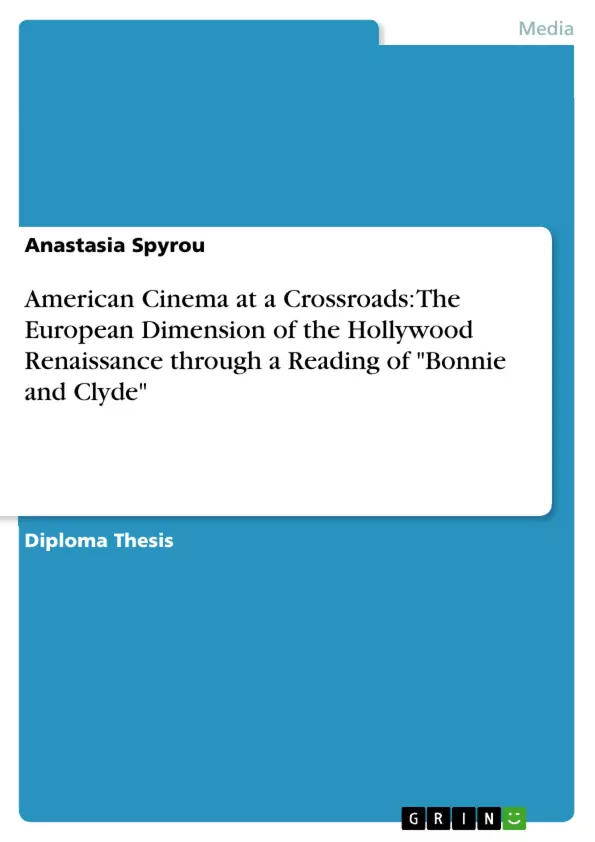The genesis of the Hollywood Renaissance in the late 1960s was the by-product of a synthesis of factors related to social, cultural, institutional, and technological shifts that had been taking place in the United States since the late 1940s. Within this context, the role of European cinema was crucial.
It has become a critical commonplace that the films of the Hollywood Renaissance embody a significant aesthetic kinship with the cinematic new waves that had emerged in Europe during the post-war period. This study aims this position further by demonstrating that post-war European new waves at once constituted aesthetic models for Hollywood Renaissance films and shaped key areas of the context that allowed this movement to emerge in the first place.
As far as European cinema is concerned, the emphasis here is placed on films of the French New Wave, Italian Neorealism, and New Italian Cinema.
Through an extensive use of textual and contextual evidence, this thesis investigates the origins, nature, and extent of the formal impact that post-war European cinema movements had on American filmmaking. It is argued that, inspired by their European counterparts, Hollywood Renaissance filmmakers experimented with all the components of a film: mise-en-scene, cinematography, editing, sound, and narrative style – often aiming to create in their pictures the acute sense of realism that European post-war films conveyed. A more frank approach towards traditionally ‘taboo’ subjects was also employed.
Arthur Penn’s Bonnie and Clyde (1967) – the film that, according to critics at large, articulated an aesthetic ‘break’ with the classical tradition and signaled the beginning of the Hollywood Renaissance – is employed as a case study, as it epitomises the European influence in social, cultural, and institutional terms.
This study also considers the continuing influence of European cinema on American cinema post Bonnie and Clyde, arguing that in recent years, several American directors have re-discovered the pioneers of post-war European cinema movements and have attempted to recreate the spirit of new wave films in their own pictures.
Inhaltsverzeichnis (Table of Contents)
- ABSTRACT
- INTRODUCTION
- CHAPTER ONE
- The Social and Cultural Conditions for the Reception of European Films in Post-War America
- 1920-1946: Brief Overview
- Hollywood in the Shadow of the Paramount Decision and the 'Red Scare'
- The 'Juvenilisation' of Hollywood Films and the Challenge of Television
- The Emergence of the Art House Movement
- CHAPTER TWO
- The Italian and French New Waves and Their Impact on American Cinema
- Documenting the Social Reality of Post-War Europe: Italian Neorealism
- The ‘Personal' Cinemas of Federico Fellini, Michelangelo Antonioni, and Luchino Visconti
- A Cinema of Artistic Rebellion: The French New Wave
- The Aesthetic Impact of European Cinema on American Directors of the Hollywood Renaissance: Overview
- CHAPTER THREE
- Delving into the Zeitgeist of Sixties America: Bonnie and Clyde as a Product of a European-Oriented Cultural Context
- Introduction to Bonnie and Clyde
- An Infatuation with European Cinema: American Film Schools of the 1960s and the Pioneers of the Hollywood Renaissance
- The Creators of Bonnie and Clyde: Robert Benton, David Newman, Arthur Penn
- Updating the Gangster Genre: Aesthetic and Thematic European Influences on Bonnie and Clyde
- CHAPTER FOUR
- On the Threshold of a 'New Hollywood': Institutional Transformations and the Role of Bonnie and Clyde
- Hollywood at a Crossroads: Industrial Shifts until the Mid-1960s and the Production History of Bonnie and Clyde
- Redefining the ‘Permissable': Bonnie and Clyde and American Censorship
- 'A Cheap Piece of Bold-Faced Slapstick' or 'The Definitive Film of the Sixties'?: Critical Campaigns Related to Bonnie and Clyde in the 1960s
- In the Aftermath of Bonnie and Clyde: The Hollywood Renaissance and the American Auteur
- EPILOGUE
- The Legacy of European New Waves in Contemporary Cinema
Zielsetzung und Themenschwerpunkte (Objectives and Key Themes)
This study aims to demonstrate that post-war European new waves both provided aesthetic models for Hollywood Renaissance films and shaped the context that allowed this movement to emerge. The focus is on films of the French New Wave, Italian Neorealism, and New Italian Cinema. The thesis explores the origins, nature, and extent of the formal impact that these European cinema movements had on American filmmaking.
- The influence of European cinema on American cinema during the Hollywood Renaissance.
- The aesthetic and thematic similarities between European new wave films and Hollywood Renaissance films.
- The social and cultural conditions that contributed to the reception of European films in post-war America.
- The role of Bonnie and Clyde as a case study of the European influence on the Hollywood Renaissance.
- The continuing influence of European cinema on American cinema after Bonnie and Clyde.
Zusammenfassung der Kapitel (Chapter Summaries)
This study analyzes the relationship between European cinema and the Hollywood Renaissance, focusing on the specific case of Bonnie and Clyde. The first chapter examines the social and cultural conditions in post-war America that allowed for the reception of European films, including the impact of the Paramount Decision, the 'Red Scare', and the rise of television. The second chapter explores the Italian and French New Waves, specifically examining their influence on American cinema. The third chapter delves into the cultural context of 1960s America and examines how Bonnie and Clyde embodies the European-oriented cultural context. The chapter also explores the film's production history and its significance as a turning point in American cinema.
Schlüsselwörter (Keywords)
This study explores the interplay between American and European cinema, particularly focusing on the influence of the Italian and French New Waves on the Hollywood Renaissance. Key terms include: European cinema, Hollywood Renaissance, New Wave, Neorealism, Bonnie and Clyde, Arthur Penn, American auteurs, aesthetic influence, cultural context, industrial shifts, and censorship.
- Quote paper
- Anastasia Spyrou (Author), 2004, American Cinema at a Crossroads: The European Dimension of the Hollywood Renaissance through a Reading of "Bonnie and Clyde", Munich, GRIN Verlag, https://www.grin.com/document/1143531



